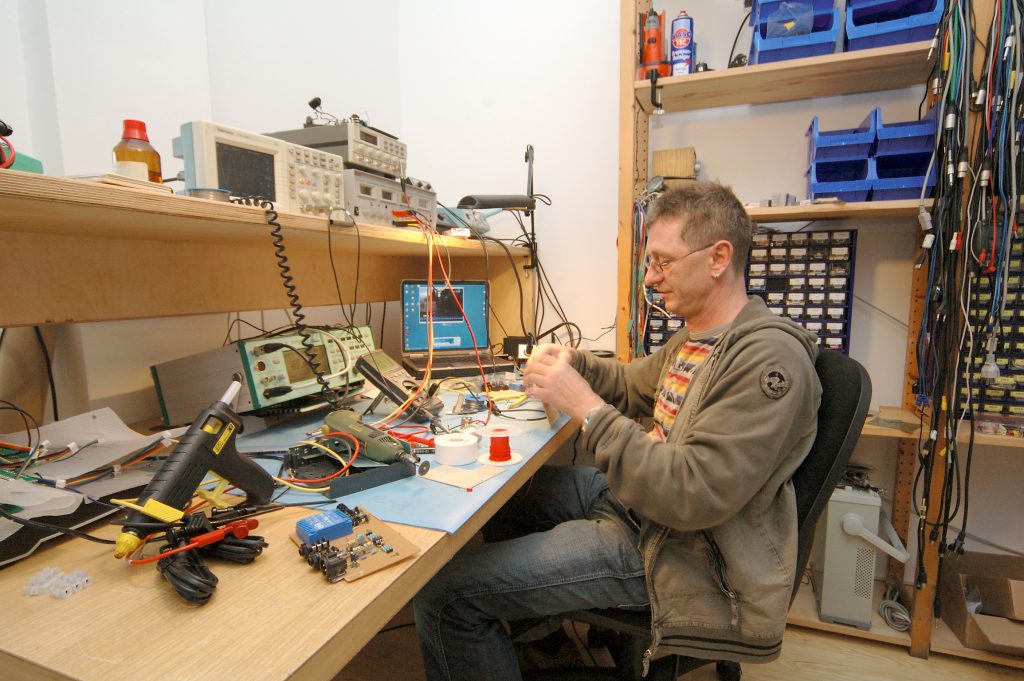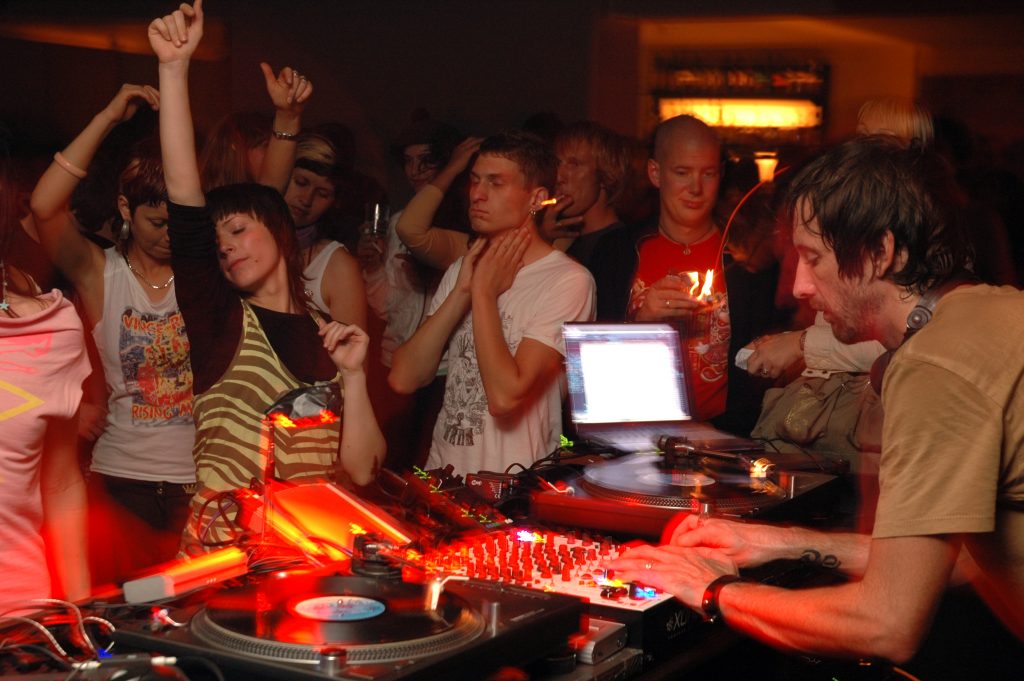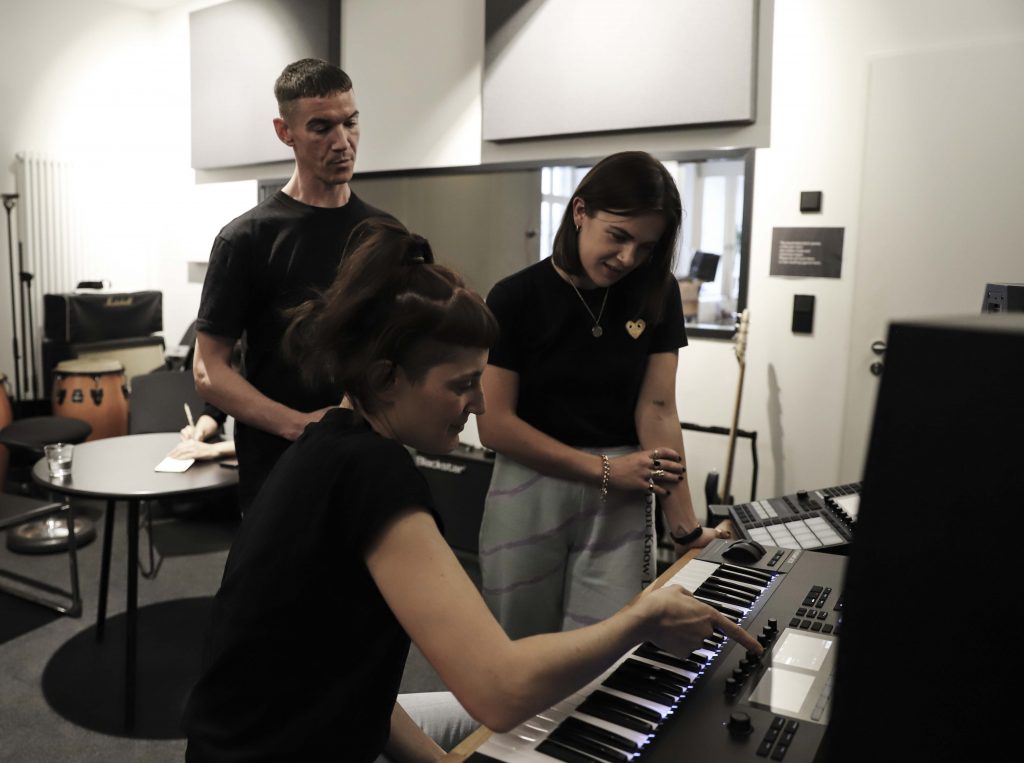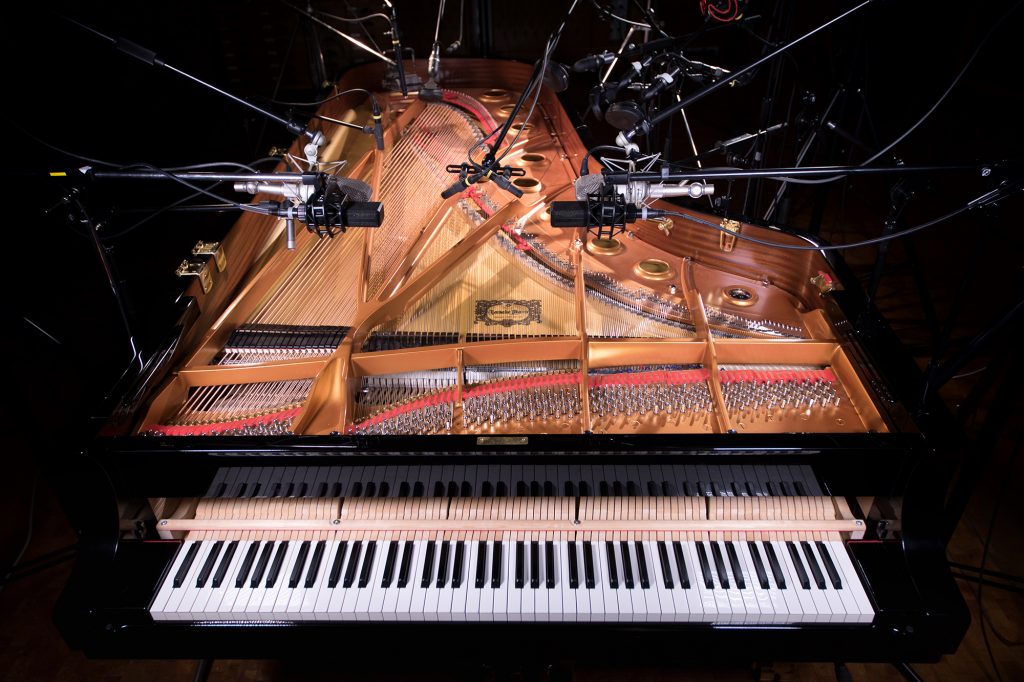An Oral History of Native Instruments
CEO Daniel Haver covers milestones and hilarious anecdotes from the music brand’s 20-year existence

In Berlin’s neighborhood of Kreuzberg—a place that’s become representative of the city’s nightlife and creative scene—the physical presence of Native Instruments (NI) wordlessly exhibits the success of a company that consisted of three people and a wild idea 20 years ago. The idea: a musical instrument, specifically a software-based modular synthesizer, that could be played and manipulated real-time inside a personal computer—at a time where you either needed access to a lot of money or a university to experiment beyond analog synthesizers.
Today, NI has become an industry standard in music production—their instruments and effects have been used by artists of all genres, from Radiohead (particularly Kid A) to Skrillex. Now, they’re buckling down on their original mission to democratize music-making. Recently they launched their most affordable equipment yet, in order to reach new consumers—especially women and younger composers. For example, the compact Machine Mikro Mk3 beatmaker costs $259 and comes with heaps of software, and NI has also developed a quick start guide to help those who have been too intimidated to dive into the world of electronic music.
How does a music tech company stay relevant in a post-Napster era where you can even make music on your iPhone? We visited the headquarters to find out—meeting with CEO and co-founder Daniel Haver in his minimalist office.

Can you tell us about your beginnings at Native Instruments?
“It’s really a matter of fact that I’m a rather rare kind of animal in this company because a lot of people here come with either a very strong engineering background or a very strong musical background. And I have neither of them. So I’m the guy that—when I go back into history—really empowers creative people. This is what I consider to be my job, a catalyst if you want. Before coming to Native Instruments—well, let me start even a little earlier. I’d been working for seven/eight years in the advertisement business. And I came in, and I was a service provider, with graphic design. I loved print stuff. Working with some of the best advertisement agencies in Germany at the time.
So I have that history. And the other is that I came into that industry when [Adobe] PageMaker 1.0 was released and I got a crack version of it from the guy who later on would start Ableton—which is just a couple of streets down—and who was at the time my best friend. With PageMaker 1.0, I went through the whole digitization transformation of the print and graphic design industry. I literally came in when the computer, for the first time, was the vehicle that you could actually use to get amazing print results by just looking on the screen. You know, the term back then was, “What you see is what you get.” But back then, things never looked like they were looking like when you printed them later—but it started to look like it with PageMaker. I saw that transformation of a whole industry and then came something on top that made all the difference: electronic music.
The day that I learned about what we call today “electronic music,” it changed my life
I was a late-starter, I have to admit it. I think it was ’94 when I really got into electronic music. Before that was goth and rock and grunge, alternative. I actually had long hair most of my life, and looked really hardcore. Went to New York in ’91 with a bandana, and then I was asked for drugs—that was pretty impressive. Anyway, the day that I learned about what we today call “electronic music,” it changed my musical life. Literally. In Hamburg, there was a satellite radio station called EvoSonic Radio. And they were the only station in Germany that played, all day long, electronic music: hardcore techno, dub, drum’n’bass, what have you. I was totally sucked into it. I just loved that so much.

Take these three pieces: my passion for music, digitization/transformation of a whole industry, working with creative people. And then my friend Bernd [the same guy who went to Ableton later] tells me, “Hey, there’s these two freaks in Berlin. They started this thing, they call it Native Instruments, and I wanna join them.” He was a superstar developer in Hamburg, in a completely different industry, but really great engineer. And he joined them—that was already great support.
Because we were best friends, we talked almost every day. He moved to Berlin into one of these flats—East Berlin at the time? Man, I mean, he told me he just moved into this flat without a shower. He has to go to the gym—no, it was not a gym, it was a public bath—to take showers. But that was Berlin style at the time. We talked every day and yet, there was no business connection from me to them. I was just like, “Wow, that’s really cool shit that you do, the software that you’re working on, amazing. The music that I listen to is all about electronic stuff; you guys can really contribute to that.”
My memory was this amazing moment Bernd called me: “Look, Daniel. We’re three engineers and musicians. We have no clue how to turn this into a company. And we’re right now in negotiations with this company from Hamburg, and we’re just overwhelmed. I know you’re a good business guy, an entrepreneur. You have a passion for the results for what we create here. Don’t you want to consider joining us?”
The next morning I said, “Yes, I want to do this” and then offered my services to the original founder, Stephan. He was not too excited, I think: “What the hell do we want with this business guy?” And he had just had some awkward experience with another salesperson. But at the same time he realized that we needed someone like that. So they didn’t have any money to pay me—I had to bring money.
And then we were six. Then the craziness started.
And then I said, “All right, then. Give me shares. And I want to become the Managing Director.” That was the proper title at the time, because we didn’t have any employees. I received my shares, I brought money, because otherwise the guys would have been starving. They literally didn’t make any money. And then two other guys joined at the same time—and then we were six. Then the craziness started.

Tell us a little about beating the competition, or staying ahead.
The good thing is, the music industry is always last to the table. This is the reality. And I came from the top agencies in Germany back then, and I looked at the marketing that the people did in this industry. And that convinced me, “Oh my goodness! They really market stuff like that? The Guitar Hero in the front and just an ugly background?” It was a pretty niche industry. So I felt, with my background, my business expertise, my marketing expertise, and my passion for music that there was no doubt at all.
But when I joined, I realized if the Japanese get what we are up to, they’re gonna kill us right away. Because at the time, the Japanese synth giants—Yamaha, Korg, Roland—were dominating the market. And I was like, “If they find out what we do, and they copy that, then we’re done.” I avoided it by getting into venture capital.
Today it’s nothing, but I got three million Deutschmark (about €1.5 million) for the company. Then I had a great time spending it. Oh, I had the nicest, coolest campaigns. We did a very bold thing because we did something that no one had ever done in this industry—think of a full-page advertisement that just has a goldfish bowl with a goldfish in it. And it just said, “Accept no limits. Native Instruments.” That’s it! No product on the advertisement, no nothing. Why could we do it? Because in our industry, [our product] was unseen. We did this and we got attention.

What’s one of the biggest or most memorable moments?
The biggest moment for sure was when we could prove to the world that a software instrument is a real instrument. Because when I started, everyone said, “That’s toy-ish. This is a computer instrument sound.” Really this moment: we are at the NAMM show in 1999. We have the B4 Organ—an emulation of the Hammond organ we called B4. And Stevie Wonder comes by. He puts on the headphones and he says, “Wow. That sounds like the real thing.” That was the moment.

You work with and against the industry, explain that to us.
People in this industry usually—there are exceptions—don’t think really big. At least that’s my impression. That leads to the fact that we have a lot of good things, maybe great things, but it’s totally fragmented. Everyone does their own little thing. So if you wanna make music, if you wanna produce a song, this is challenging. And it’s challenging not because the tools themselves are complex, but just to go through the, “Where do I find it, how do I update it, how do I register…” You have to go through a million different manufacturers and it’s very inconvenient.
We need to do something for the whole industry and not just for ourselves
So we realized that if we really want to empower anyone to make music, we need to do something for the whole industry and not just for ourselves. The first big step was Native Kontrol Standard, NKS. I’m not sure if you’re familiar with that, but it’s basically the standard for all software instruments and effects in our industry. It’s a standard that makes it just much more easier to browse across, I don’t know, hundreds of instruments and effects and find the sound that you need because it’s all well-tagged. And then if you use our hardware, you can immediately—the knobs and everything are assigned exactly to the parameters that you want. So it’s really convenient.
In the beginning, there was a time where we thought we could do everything on our own—very Apple-style. I liked that idea: all under control, we built our ecosystem. That was because I grew up in the ’90s, but in the 2000s things changed. And suddenly it became obvious: it’s all about collaboration. It’s all about working together and not building a fortress. So my partner Mate and I, we changed the strategy from a closed ecosystem to an open ecosystem.
Everything that NKS does, all of our instruments did already years before that. But that was the moment where we said, “Now, if we want to make a difference, we have to invite the whole industry.” And because we are such a dominant player in our industry, we could actually make all of our competitors adapt to that standard. And they actually all appreciate it because the users appreciate it. Even the people that really hate us, at some point they came up to us and said, “We hate you! Can we also support NKS?” and we said, “Sure you can! No problem! We hate you too!”

What are your thoughts on the future of music software—and staying relevant?
If you want to own software, you’re in the wrong age. You could never own software and you will never own it because—the day you buy it, it’s complete; it’s outdated. Two or three months later, we release the next instrument. The next month, another. And the next month another, and then we release some presets… And then 12 to 18 months later, we release an update that then has it all. When I say software as a service, I say consciously software as a service and not just subscription. Because subscription is just another business model. Software as a service is really this idea that you receive, all the time, additional benefits and value that you wouldn’t get if you just subscribed to the same thing. It’s just a financing model. “Rent-to-own” as such.
We will do subscription—but with additional value. It’s not just another—it’s not just financing [model], it’s continuously updated. You obviously don’t have to pay for that update extra, it’s in your subscription. You get new presets, you will get new loops and samples, whatever you need. We will take care of you if you subscribe to Komplete. Komplete today—I think the instruments and effects are about 100 in the biggest box that we have to offer. Again, every month on average, a new instrument is coming. So today you have to wait a year to maybe buy an update or you buy à la carte, at a very high price, every single item—which no one does, rightfully. With a subscription to Komplete: whatever we release, it’s yours, that day.
Our strategy was always top-down. For us, it was important that Coldplay and Hans Zimmer and Metallica adapt our products—and then we bring it to a wider audience. And it just took us, especially on the hardware side, a long time to be able to create the right products at the right price-point.
And that is literally now. Literally now, for the first time in our history, we’ve released from all three brands products that are below $300; down to $150 for the A25 keyboard. So we are now in the first time in a price range that is considered in our market “entry-level” price-point.
What we now open up is two doors: expect to see our products in Best Buy and Walmart. Not tomorrow, but in the near future. So we will be in channels where there are more consumers, we will have the hardware price-points, and it will also be accompanied by subscription software.

And the second door that we are opening with this is the emerging markets. Because today, I can tell you Native Instruments’ business is fantastic in all developed markets: Australia, Japan, all of Europe, all of North America. Now ask me how it is in the emerging markets—and the answer is, it doesn’t exist. This is for two reasons: especially Latin America, there are high duties for hardware imports, so hardware must be really cheap to be affordable in the country.
And software, people are just not willing to pay for, period. Doesn’t matter if they’re rich or not. And that’s been proven from other industries. This is why my job is not as hard as it may seem: the only thing that I also had to do back then in ’97 was [find out] how did other industries do it? What was happening in other industries? Because that is gonna happen to us, too. I know for a fact that subscription really works in the emerging markets because of the convenience factor. You can find any software on a peer-to-peer network, no problem—even the recent ones. There’s always, within a week, a crack of all of our software available. Is it convenient to find it? Is it convenient to update it? Do you know if it’s going to be more buggy or not? And so on and so on. If the price-point is right, people are willing to pay for a subscription offer, to a software-as-a-service offer. And that’s what we’re gonna do.












